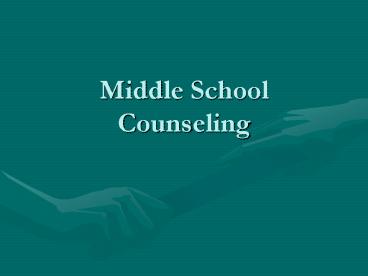Middle School Counseling PowerPoint PPT Presentation
1 / 12
Title: Middle School Counseling
1
Middle School Counseling
2
Developmental Needs of Middle School Students
- Vernon (1999)
- Physical changes occur rapidly for ages 11-14
more so than any other age except infancy - Puberty begins at about age 11 for females 13
for males - Rate of growth varies among students, making for
self-consciousness and anxiety - Both males and females become clumsy with hands
and feet that are disproportionate to other body
parts
3
Ages 11-14
- Locker-room phobia is common
- Shift from concrete to formal thinking begins,
but is not completed until age 15 - Self-definition and integration begins push for
independence and autonomy at the same time,
still immature and lack life experiences - Often contradict themselves want to be unique
and just like their peers - Very egocentric
4
Ages 11-14
- Look to peers for support, more vulnerable to
peers making fun of them, rejecting, etc. - Often have trouble looking at anothers viewpoint
because of preoccupation with their own needs - Ride an emotional roller coaster moody,
emotional outbursts - Troublesome emotions anxiety, shame,
depression, guilt and anger also occur more
frequently
5
Comparing Elementary and Middle School Counseling
- Vernon (1999) case studies
- Muro Kottman (1995) differences
6
Program Development
- Who is involved?
- What are the decisions?
- Where do we look?
- What guides our work?
- How do we determine the order of our work?
7
Applications
8
Expressive Arts
- Therapeutic Fairy Tales (Erford, 2003)
- Writing fairy tales allows students to project
themselves into another time dimension, where
they can positively resolve particular issues or
conflicts (Gladding, 1997, cited in Erford,
2003). - This works well in groups can be used in IC
9
Directions for Fairy Tales
- Exercise is completed in 6-10 minutes
- Do the following
- A. set the scene in a place and time far away
from the here and now - B. within the setting, describe a problem or
predicament - C. solve the difficulty in a positive and
gratifying manner, even if the solution seems
unrealistic or bizaare
10
Fairy Tales
- After students write stories, ask them to read
them aloud - To process what has occurred, the counselor asks
facilitative questions - A. In what ways are you like the main character
in the story? Different? - B. In what ways does the predicament affect the
characters? Is the predicament, or the resulting
emotion, familiar in any way?
11
Fairy Tales
- C. How is the solution pleasing? How is it
implemented? How does it compare with the way you
typically solve problems - As students read tales, look for use of symbolic
and metaphoric language - Metaphors provide insight into how students view
the world and understand experiences - Counselors can continue to use metaphors with the
child to express empathic understanding
12
Career
- Check out the following websites
- www.collegeboard.com
- www.bls.gov/oco/ this is the Occupational
Outlook Handbook go specifically to the
following site. Choose an area and bring back
information to discuss in class - www.bls.gov/k12/html/edu_over.htm
- www.careerkey.org
- www.pnc.edu/sa/discover/interests.html

